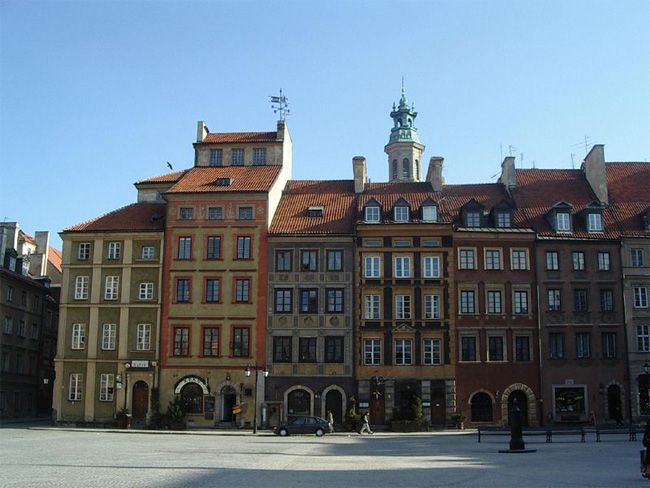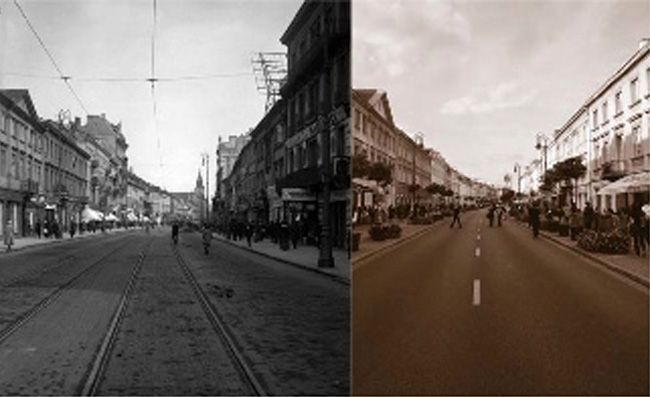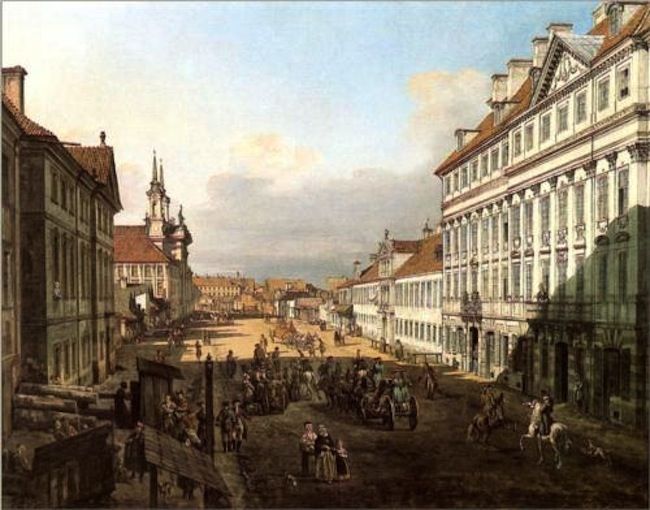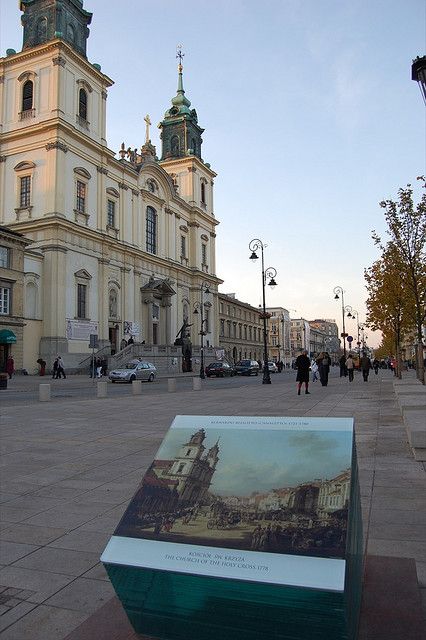Like many cities in Central Europe, Warsaw is made up largely of grey, ugly, communist block-style architecture. Except for one part, the Old Town.

Walking through the historic district, it’s just like any other quaint European city. There are tourist shops, horse-drawn carriage rides, church spires. The buildings are beautiful—but they are not original.
During World War II, German forces razed more than 80% of Warsaw. After Soviet troops took over, much of the city was rebuilt in the communist-style: fast, cheap, and big. They built apartment blocks, wide avenues, and heavy grey buildings. It was communist ideology in architectural form.
But when it came to the historic district of Warsaw — the Old Town and a long connecting section called the Royal Route — they decided not just to rebuild, but to restore. Builders would use the same stones and use special kilns to make special bricks to preserve its authenticity. After six years of reconstruction, the new Old Town was opened. Poles were ecstatic to have it back. Even in the West, it was seen as a triumph of the human spirit.
But here’s the thing: Warsaw’s historic Old Town is not a replica of the original. It’s a re-imagining. A historic city that never really was.
Look closely.

Not long after the Old Town was rebuilt, people started to notice that it was a little bit off. People wandered around and felt this uncanny disjuncture between the city that they remembered and the city in which they now found themselves.

Despite the push for authenticity, it turned out that the major inspiration for the rebuilding of the city were the paintings of an 18th Century Italian artist named Bernardo Bellotto. Bellotto was a “vedutista,” one who specialized in the Venetian style of painting in which cityscapes are depicted realistically, with their details and documented precisely.

But Bellotto had a tendency to make “improvements” on the cities he painted, relying as much on his artistic license as what he actually observed. The paintings from the 18th Century were never meant to match reality — they were supposed to be better than reality.

For the Soviets, this reconfiguration of the Old Town served two purposes. First, they wanted to send the message that the Old Town — and Warsaw as a whole — would be better than it was before the war. Second, they didn’t want Poles to long for this lost part of the city. By recreating Old Town, the past could stop being such a distraction, and they could get to work on a drastic overhaul of the country.

Today, placards with Bellotto’s paintings stand beside buildings, inviting passers-by to marvel at their likeness.
Our story this week was reported by Amy Drozdowska and Dave McGuire, who spoke with Warsaw-born anthropologist Michał Murawski about Warsaw’s complicated history.
NOTE:
This week’s episode is sponsored in part by Sidewalk Radio with Gene Kansas, which covers the art, architecture, design, and urban planning of Atlanta, GA, and beyond.




Comments (15)
Share
I’ve just stumbled upon this show and while I find it extremely interesting as a whole the part on Warsaw Iis sadly a bit lacking.
The main problem is the picture of Warsaw as comprising of a tiny reconstructed old town surrounded by a monotnous sea of ‘huge, grey, ugly communist architecture’ (a sample of very professional architectural vecabulary by the way)
1. First of all it is simply factually incorrect. The old town and the Royal Route are neither the only not the biggest areas with pre-war architecture in Warsaw. For a short list you have:
– a large area of relatively luxurious late 19th – early 20th century tennement houses (most of downtown south of Jerozolimskie Avanue, left intact as Germans made it their living quarters during the occupation)
– an even larger area of largely neglcted late 19th – early 20th century tennement houses and vintage industrial architecture in Praga district, at the left bank of the river (this was already controlled by the Russians when Hitler’s order of levelling the city was carried out on the right bank)
Notice that both areas mentioned above – contrary to what is said on the show – attarct quite a lot of tourists, largely because significant part od city’s nightlife can be found there, as opposed to the Old Town which is goes to sleep pretty early
– distircts of Ochota, Mokotów and Żoliborz which were outer suburbs largely build up in the inter-war era and therefore contain a nice selection of early 20th century styles (think Bauhaus etc.). These were also left largely untouched by the planned destruction of the city center.
And even in the areas of the city center where the destruction was the biggest there were still individual buildings left standing which were later incorporated into post war city planning, adding to a peculiar mix of architecture typical for downtown Warsaw. Various bad things can be sad about the architecture of central areas of the city, but ‘uniform’ or ‘monotonous’ are not among them. There are of course large commieblock neighbourhoods further from the center, but these were largely build outside of pre-war city limits, on areas that in 1939 would be farmland or sparsely settled outer suburbs.
2. The other thing is that under this ‘huge grey ugly communist architecture’ you are mixing up two very distinct architectural styles, a) socialist realist (also known as socialist classical) style of high Stalinism
http://en.wikipedia.org/wiki/Stalinist_architecture
and b) le Corbusier influenced modernism, which replaced the former rapidly as a dominant architectural style after political changes of 1956.
This difference is essential for understanding the main issue here, that is why the communist decided to rebuild the Warsaw Old Town (and many others similar areas – you may not be aware of it, but the old towns of Poznań or Wrocław or Gdańsk are also to a large degree post war reconstructions).
It can be argued that those reconstructions were essentialy connected with the ideology of socialist realism – the architecture ‘national in form, socialist in essence’, in other words a certain mixture of local traditions and even some form of nationalism with universal communist ideology. An interesting example of a transition between a proper reconstruction and a socialist realist architecture in it’s pure (as exeplified in Warsaw by Palace of Culture or Constitution Square) is Mariensztat district, not far from the Old Town. To the untrained eye it may look like some kind of preserved or reconstructed historical district, while in fact it has nothing to do with what stood there before the war – it is a residential neighbourhood designed and build in late 40s in a human-scaled version of socialst classical style.
http://warszawa78.blox.pl/2007/05/A-moze-zajrzymy-na-Mariensztat.html
Does it really look ‘huge grey and ugly’?
Now what most people refer to ‘grey communist architecture’ is what came after 1956, that is the local version of le Cobusier influenced modernism. It was basically architectural mainstream back then everywhere in the World – and architects and city planners in communist countries embraced it as soon as political pressure to stick to socialist classical style was over. Under this ideology in architecture reconstruction of the past in any form was seen as an anathema, and the reconstruction of old town centres largely stopped. Notice that this is the same period (late 1950s-early 1960s) when the British demolished large parts of their historical city centers to give way for motorways and concrete tower blocks. It was a global current in thinking about architecture and city planning, not restricted in any way to the eastern block countries.
The above argument is neccesarily very short and simplified, but the point is: if you see a former eastern block city consisting of reconstructed old town and commieblock residential areas around it (Warsaw, as mentioned, not really being good example of) then you have to know that this parts were probalby bulit in different times (the reconstrution before 1956, the commieblocks in 1960s or later) and that the architects and planners which did this acted under vastly different ideologies. Some of those Corbusianist designers of 1960s commieblocks would likely oppose the earlier reconstruction (as creating ‘movie sets’, being ‘fake’ etc), had they have any say in it. It is a gross simplification to see all of post WW2 eastern block architecture as stemming from a single, uniform idea.
3. And the last, about corbusianist modernism being ‘huge, grey, ugly and communist’. There is a strong movement currently in Poland of vindication of this architecture, people are starting to see value in it, dscussing the ways to preserve better examples of it and the proper way of repairing or improving the not-so-good ones. Actually a person who consistently refers to all of post WW2 modernism as ‘huge, grey, ugly communist architecture’ as one of authors of this piece does, would (not just among the architecture buffs) be seen as a phillistine, to put it mildily.
wow !
C. ! You are sharp ! you got a blog or something ! I llstarts reading it
Well put.
Denying the link between Soviet political beliefs and post WW2 modernism is folly. Le Corbusier’s aesthetic—dehumanizing and brutal—were a quite explicit attempt to elevate the power of central planning over small scale democracy. It wasn’t “global”. It was an explicitly political project pushed by one of the most reprehensible and dehumanizing autocracies in history. So the comment was correct—they are indeed huge, grey, ugly and, quite explicitly, communist.
Any reading recommendations for someone who wants to dig deeper and read more about the city and its history? (Academic monographs welcomed over travel guides!)
worldcat.org is a good place to look for books — covers library holdings throughout the US and beyond. A search for Warsaw Architecture History brought up this book: http://www.worldcat.org/title/warsaw/oclc/52486116, and this one: Building and architecture in Poland 1945-1966 (http://www.worldcat.org/title/building-and-architecture-in-poland-1945-1966/oclc/15389)
What’s the beautiful song at the end?
This is what I want to know as well! (I came here hoping to find out)
I don’t agree with what is written here about the old town. Aside from St. John’s and the uncovering of earlier gothic components of some buildings, most buildings were a faithful reconstruction even using recycled bricks. And there are about 10 buildings in the old town that are virtually authentic inside and out. Murals or frescoes in more cases were new accurate pre-war documentation was hard to come by.
and I should add all of the gothic basements are original, merely reinforced in some cases. almost all of the basements were preserved as was the original building footprint, medieval street pattern and even silhouette. Yes in cases as on Nowy Swiat street, some buildings were not rebuilt favouring the original 18th century look of the street and on these streets people may not have recognized some stretches. Further along Krakowskie Przedmiescie the same treatment was applied, but almost all of the churches are original having survived virtually intact.
Let me start by saying that 99% Invisible is my favorite podcast ever, and I really love every story you do, including this one. In fact, I listened to this podcast when it originally came out over 2 years ago, and it has stuck with me ever since. Fast forward to now, I am about to start my masters in Historic Preservation and I have been reading James Marston Fitch’s “Curatorial Management of the Built World.” In the last chapter he discusses the reconstruction of Warsaw after WWII. He explains that during the restoration and reconstruction, the Polish conservationists had to decide to what stage of history each structure should be “returned.” Using John’s Cathedral (not to be confused with John’s house, above) as an example, Fitch explains that the conservationists deliberately decided against restoring the gothic facade, and instead choose to restore the building to an earlier state with the stepped gable as depicted in Bernardo Belotto’s paintings. To determine their accuracy, Belotto’s paintings were compared with the extensive catalogue of measured drawings that the architecture students at the polytechnic were required to make of the old buildings in the Stare Miasto (it appears that they had an abundance of accurate pre-war documentation). Fortunately, most of the drawings survived the war and they were used in conjunction with the painting of Bernardo Belotto to provide the basis of restoration and reconstruction in Warsaw. Anyways, I hope this only adds to the interesting history of Warsaw.
I’m a big fan of the show and I was delighted to stumble upon this piece about a city I’m currently living in… that is, for the first couple of minutes, because I couldn’t bear to listen to it any longer.
The comments above explain in detail why referring to the ‘communist ideology’ in architecture as ‘huge, grey and ugly’ is a huge blinking neon sign of ignorance. I’ll add to it that claiming that ‘the old town that never was’ is probably the worst headline for the Warsaw’s historic district and its reconstruction one can imagine. Architecture students have documented this area before (and, if I remember correctly, also during) the war in a better and more detailed way than any other in the city ever has and largely thanks to their efforts (and prof. Zachwatowicz’s fight to preserve the documentation) we can now walk the streets looking like those that once were.
You can read and see some more about it in a ‘Building a new home’ book among others: http://lubimyczytac.pl/ksiazka/158057/budujemy-nowy-dom-odbudowa-warszawy-w-latach-1945-1952
The Polish effort of reconstructing Warsaw shouldn’t be attributed to the Soviets. It originated not as a decision in Moscow but as a spontaneous decision of the inhabitants of the city. Some Soviet soldiers took part in reconstruction, but the vast majority of the work was made by the Poles and it was financed by the Polish diaspora (Polonia). Saying that “Soviets rebuilt Warsaw” is doubly offensive – not only they were an occupying army, but their inaction led to Warsaw’s destruction.
Calling Soviet architecture and urban planning “grey and ugly” is the most ignorant thing I’ve heard in 99% invisible (and i listened to a lot of it). Communist buildings, if properly maintained, do not have to be ugly or grey. Once you get past these easily solvable issues, you realize how we actually need to go back to those “ugly, grey” buildings: they are space-efficient, community-centric, have huge public spaces around them, allow for much greener and healthier cities (in right hands) — all this matters, of course, if you’re looking for something a bit more than bunch of ornate buildings to take photo in front of.